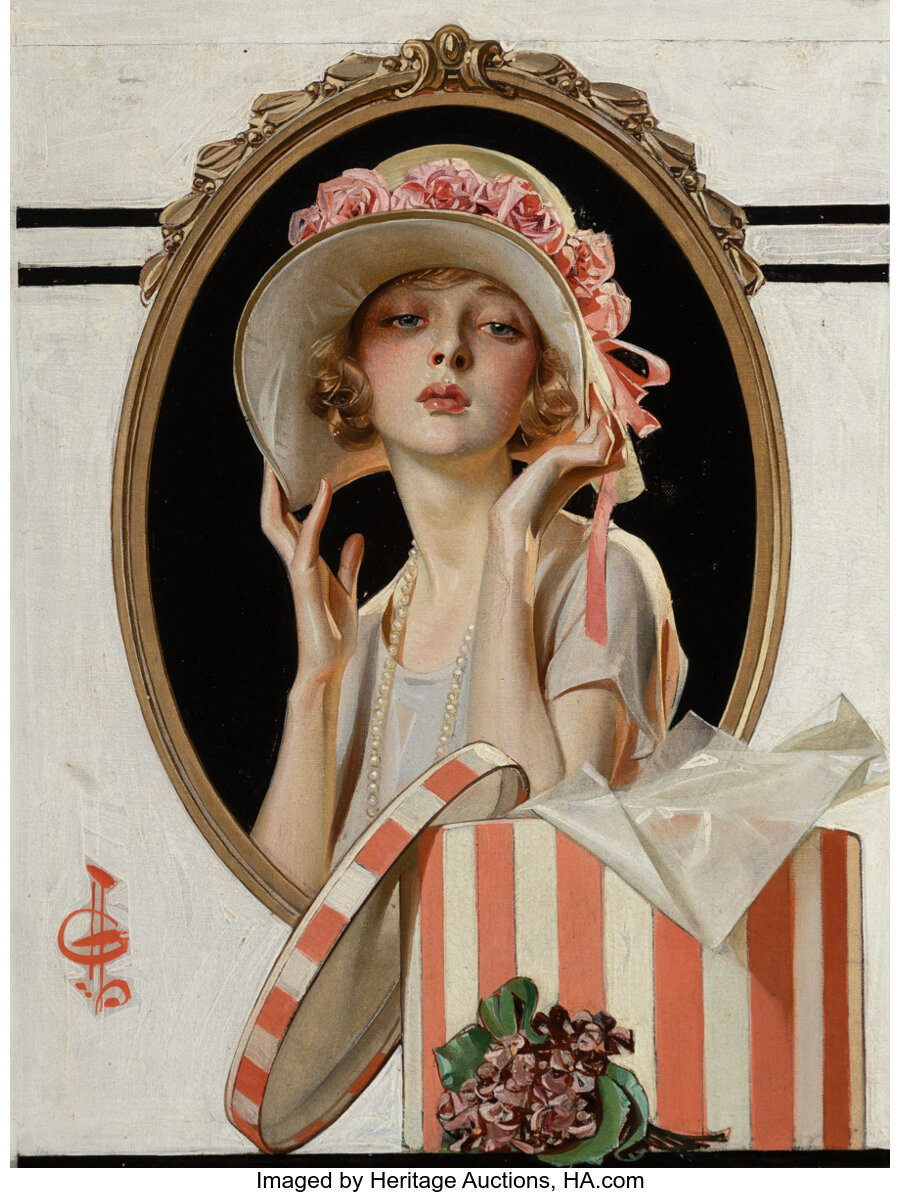Joseph Christian Leyendecker (American, 1874-1951) Easter, The Saturday Evening Post cover, April 15, 1922 Oil on canvas laid on board 20 x 15-1/8 inches (50.8 x 38.4 cm) Signed with the artist's monogram lower left: JCL PROVENANCE: Orison W. MacPherson (1898-1966), New Rochelle, New York; Orison W. MacPherson (1935-2022), Darien, Connecticut, by descent, 1966; By descent to the present owner. EXHIBITED: The National Museum of American Illustration, Newport, Rhode Island, n.d. LITERATURE: M. Schau, J.C. Leyendecker, New York, 1974, p. 187, illustrated; L.S. Cutler, J.G. Cutler, J.C. Leyendecker, American Imagist, New York, 2008, p. 137, illustrated. As one of the defining figures of the Golden Age of American Illustration, Joseph Christian Leyendecker distinguished himself through a highly polished, instantly recognizable style that shaped the visual identity of early 20th-century America. Best known for his prolific work with The Saturday Evening Post and fashion houses such as House of Kuppenheimer, Leyendecker portrayed idealized figures—men, women, and children alike—with an unmistakable blend of glamour, grace, and modern sophistication. His command of form, fashion, and composition, particularly his innovative use of negative space and stylized modeling, allowed him to transform commercial illustration into a refined and resonant art form. Born in Montabaur, Germany, Leyendecker immigrated to Chicago with his family in 1882. He received early artistic training as an apprentice at J. Manz and Co., a prominent printing firm, and later studied under John Vanderpoel at the School of the Art Institute of Chicago. In 1896, he traveled to Paris with his brother Frank to attend the Académie Julian, where he absorbed the aesthetic innovations of the French Art Nouveau movement and refined his use of the hachure technique—parallel linear strokes in lieu of traditional blended shading. This graphic sensibility, combined with a distinctive mixture of oil and turpentine that allowed for layered, cross-hatched textures, became a hallmark of the artist's mature style. Easter, a cover illustration for the April 15, 1922 edition of The Saturday Evening Post, exemplifies Leyendecker's synthesis of cultural observation and technical virtuosity. Created during the transformative decade of the 1920s—a period marked by economic prosperity and a rapidly evolving sense of modern femininity—the painting is at once a fashionable portrait and a nuanced commentary on the shifting aesthetics of American womanhood. A young woman stands before a gilded mirror, elegantly dressed in strands of pearls and a lavish Easter hat, her cropped hairstyle and tailored ensemble echoing the streamlined silhouettes of the flapper era. Her pose is simultaneously poised and reflective, suggesting both admiration and contemplation. A newly opened hatbox rests at her feet, its tissue paper spilling forth, with a small bouquet tucked inside—a tactile symbol of seasonal renewal and consumer pleasure. Leyendecker's technical mastery is evident in every detail: the gleaming highlights on satin, the delicate rendering of lace and ribbon, the modulated blush of skin tones set against a rich, painterly background. The mirror functions not only as a compositional device but as a metaphor for modern self-fashioning—the doubled gaze creating an interplay between subject, reflection, and viewer. Here, womanhood is not passive; it is performed, admired, and constructed with elegance and intention. In Easter, Leyendecker captures more than a moment of seasonal festivity—he enshrines a vision of the American woman as both icon and individual. Through his refined line, decorative flourish, and acute sensitivity to cultural nuance, the artist offers a portrait of modern femininity at the height of the Jazz Age: stylish, self-possessed, and unmistakably contemporary. HID12401132022 © 2024 Heritage Auctions | All Rights Reserved www.HA.com/TexasAuctioneerLicenseNotice



